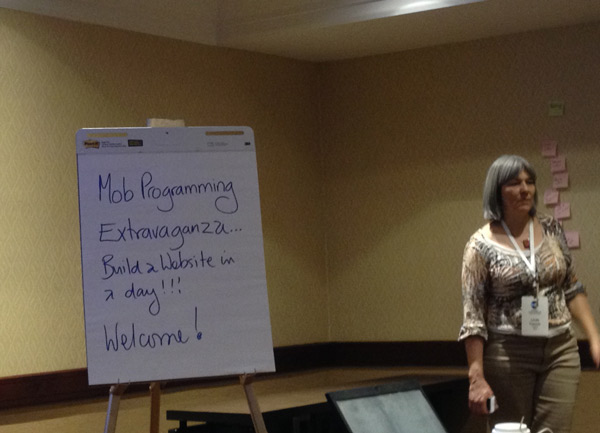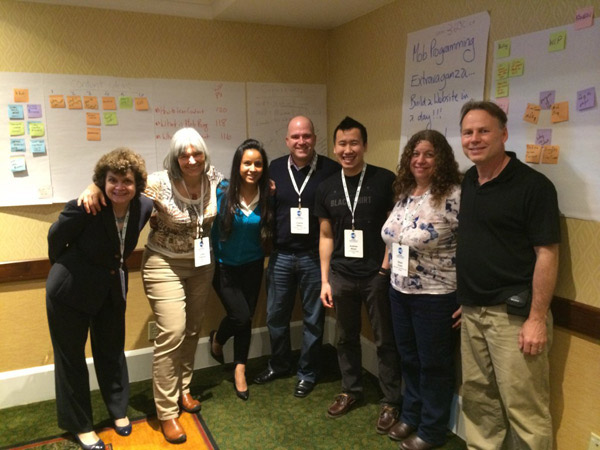Lean Content-- Building a Website In a Day at ICC2014
Labeled under: Content Strategy
If you ever wanted to jump into an all-day Lean Startup, Lean UX, Scrum, and Mob Programming environment, the “Build the Website in a Day” workshop was the place to be at Intelligent Content Conference 2014’s Workshop Day.

Linda Francis, partner at 360C, and her assistants Maria Karim and Dennis Britton, took our workshop through a fun, fast-paced Lean Content work environment.
The mission: Use the principle of continuous improvement to create a Minimum Viable Product (MVP) website for the Intelligent Content Conference. The site shares concepts and principles of Lean Content and Mob Programming and encourages feedback from the ICC 2014 crowd.
Not An Easy Process
The team did a quick introduction with one another and we jumped right into the process. No agenda, no slides, no lecture.
The general idea: “Let’s throw everyone in a room and get them working together and at the end of every day, have something that we can test.”
We went through an organic process of banding together a team of content professionals of different skill sets to build something to improve the customer experience. We butted heads, we argued, but most importantly, we learned through all of this to work together and use our strengths to the team’s advantage.
Quick Notes
Lean Content

Lean content is a new concept that converges principles of Lean and Agile product development with content planning and development. Add stakeholders and key decision makers into the mix and its an environment for quick, iterative sprints towards building MVP-type content.
Since the enterprise environment brings challenges to content creation due to silos and established methodology, the Lean Content mindset breaks teams down into their own “startups.” These small groups implement Lean Content methodology to bring a higher pace of output, learning, and adjusting to content development.
As Francis reiterated multiple times during the session, we need to get over the perfectionist nature of content development and get something useful into user’s hands. THEN, we can continuously improve that content through iteration using insights from analytics and user testing.
As far as we knew in discussion, there are no authoritative definitions for Lean Content or set of practices—this meant most of the day was experimenting, feeling around, arguing, agreeing, and getting towards a viable product with a group of specialists.
We all agreed upon a definitive goal though. As our mock website states,
“Embracing these new lean and agile methods results in more cohesive teams, better customer experience, nimble responsiveness to customer needs and stakeholder requirements.”
Mob Programming Crash Course
Mob Programming is basically the practice of throwing all product development team members together in the same working environment to create a product in real-time. In the Lean Content case, it’s to build content together.
The hypothesis is that by removing the “glass walls” between content providers, SMEs, programmers, and developers, we achieve a more cooperative and informative methodology to develop products and content.
It seems like an all-eyes-on-team member and stakeholder approach to ensure that everyone’s on the same page with any development of a product or web asset. It’s definitely not an old concept—Linda had been doing it since 1988.
With the recent surge of hackathons and popularity of Agile-type development environments, Lean Content surely has a place to thrive in an organization willing to adapt culturally and operationally.
Our Ground Rules for the Day
- Be nice to one another.
- 20-minute sprints, 5-minute planning sessions before each sprint.
- Everyone contributes.
- …and don’t forget to be nice to one another.
Our Website-Building Day in a Nutshell

- Sprint 1: Content Brainstorming
- Sprint 2: Information Architecture
- Sprint 3: More Information Architecture, prototype top-level navigation
- Sprint 4: Card Sorting: Creating Cards for User Testing
- Sprint 5: Look & Feel, Image Search
- POWER LUNCH Sprint 6: Eat & greet with our user testing subjects for a Card Sort Exercise
- Sprint 7: Prioritizing content, tasking members with ownership, concurrent development with second device
- Sprint 8: Mob content development… phew!
- Sprint 9: Identifying Pros and Cons for Lean Content
- Sprint 10: Splitting into streams—FAQ, pages, etc.
…and then we were LIVE. You can check the site out here.
Key Takeaway: Keeping Users and Stakeholders in Mind
The concept of Lean Content might put many content specialists and developers into a frantic new environment, but it’s with the intent of improving the experience of the end user while satisfying stakeholder requirements.
There are many organizations that struggle with just selling content initiatives, let alone bringing something as culturally shifting as Lean Content, Mob Programming, or an Agile development environment. Organizations that are willing to be so nimble as to adopt something like Lean Content open the doors to much more validation for their products or content. Each iterative cycle brings an opportunity for testing, commentary, and overall improvement.
The number of iterations that you can involve stakeholders and users in is practically countless. You no longer have any limitations as when to conduct user research or when to cut off discovery or alignment phases of projects. Lean Content’s iterative process gives you plenty of opportunities to check in, fix mistakes, and improve the customer experience.
The challenge is breaking down existing silos and ingrained workflows to implement this forward-thinking methodology.
Jump into the Conversation
Our mock website is by no means the definitive Lean Content guide. Our workshop team encourages ICC 2014 members and the general public to comment on anything they would like throughout the site.
Together we can add much more to the Lean Content conversation.